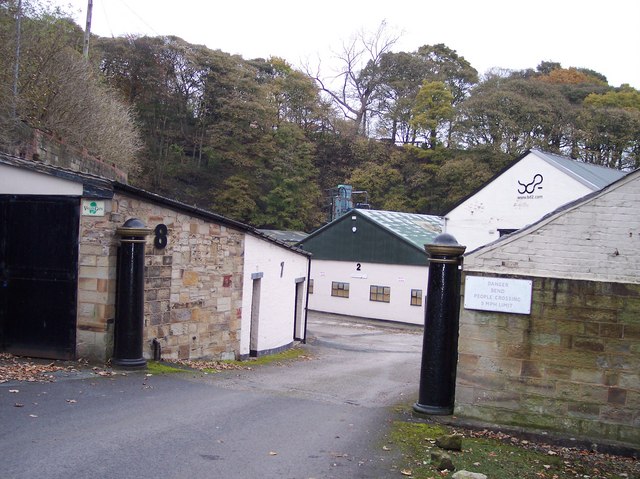Haigh Foundry on Leyland Mill Lane in the Douglas Valley in Haigh near Wigan became notable for the manufacture of steam engines, early steam locomotives and a wide range of products in wrought and cast iron. The ironworks and foundry were founded by Alexander Lindsay 6th Earl of Balcarres, his brother Robert Lindsay and iron founder, James Corbett in 1790.
In 1835 the foundry was leased by E. Evans and T. C. Ryley. The company produced railway locomotives, and in the years up to 1856 produced more than a hundred of them. Birley and Thompson leased the foundry until 1884, when it closed.
Lindsays
The Haigh HallHistoric country house in Haigh, near Wigan in Greater Manchester England. estate passed to Elizabeth Dalrymple, great niece of Sir Roger Bradshaigh, when the male line failed.[1] She married Alexander Lindsay, 6th Earl of Balcarres in 1787; the hall became his family seat and he became landlord of what was by then a delapidated estate.[2]
Brock Mill Forge by the River Douglas, a mile from Wigan, was advertised for sale in a Liverpool newspaper in 1766 and again in 1775.[2] In 1788 Alexander Lindsay, his brother Robert Lindsay and iron founder, James Corbett entered into partnership. They acquired the forge for £400 and set up furnaces at “Lalland Mill” as an ironworks and foundry in about 1790. It became known as the Haigh Foundry.[3]
When the business was set up Alexander Lindsay was a serving soldier, and his brother Robert Lindsay was in India working for the East India Company, and reluctant to move to Haigh. The earl considered his brother’s expertise in business vital to their success, and persuaded him to join the venture.[4] Meanwhile, Corbett started an ambitious expansion, setting up a boring mill to manufacture cannon, but his sudden death in 1790 left the work unfinished.[4]
Alexander Lindsay next hired John Coward from ironworks in Dukinfield to take over the management, and his brother recruited moulders from Scotland. A casting house, accomodation for the workers, and stables were built, and the weir was repaired. The blast furnace and a boring mill had been constructed by September 1790.[5]
Robert Lindsay left the business and Joseph von Baader, a young German engineer started work the following year. Baader was not a success and the ironworks performed poorly. Local coal and iron ore were unsuitable and Robert Lindsay had to return to sort out matters in 1796.[6] The two blast furnaces were operated until 1815 and demolished in 1828.[7]
The ironworks was not a success but the foundry was, particularly after Robert DaglishRobert Daglish (1779–1865) was a colliery manager, mining, mechanical and civil engineer at the start of the railway era. became chief engineer in 1804, and the works acquired a reputation for manufacturing winding engines and pumping equipment for the coal-mining industry. Daglish constructed the Walking HorseLancashire’s first steam locomotive, built by Robert Daglish in 1812 at the Haigh Foundry for colliery owner, John Clarke; it entered service the following year. locomotive for Orrell Collieries, and established locomotive manufacture at Haigh. The company made steam engines and rolling mills, and in 1818 exported a sugar mill to Haiti.[8]
Evans and Ryley
The foundry was leased by E. Evans and T. C. Ryley in 1835 for 21 years. The partners intended to produce railway locomotives, and were joined by a Mr Burrows.[9] Between 1835 and 1856 the company manufactured more than 100 locomotives, some for railways in Lancashire, broad-gauge engines for the South Devon Railway, the War Department and others for export.[10] The foundry built a swing bridge for Liverpool’s Albert Dock in 1846.[11]
In 1855 Haigh Foundry and Brock Mill Forge were offered for lease. The foundry had manufactured some of “the largest pumping engines and the most powerful factory engines in the kingdom” in the previous decade. The iron works, on the bank of the River Douglas, consisted of a foundry, five cupola-furnaces,[a]A furnace with a dome leading to a chimney.[12] three air-furnaces for making the largest castings, and another foundry for smaller pieces. Also on site were blacksmiths’ and pattern-makers’ shops, office, drawing shop, the foreman’s house, boiler yard and iron warehouse. A water-wheel driven by the river powered the machinery, line shafts and furnace blasts. The forge was powered by water and steam. Part of the works where spade making was carried out had Naysmyth steam hammers and a rolling mill. Also for lease was the firebrick and tile works, which used fire clay from a nearby pit and had a kiln, drying sheds and a steam-powered grinding wheels. The manager’s house and cottages for workers were part of the lease. A railway line connecting it to the Lancashire and Yorkshire and London and North Western Railways was being built.[13]
Birley and Thompson
By 1857 the lessees were Birley and Thompson, who concentrated on heavy engineering. The company produced stationary engines for mines, collieries and cotton mills. Locomotive production ceased, and competition from other companies producing mining equipment led to its closure in 1884.[14]


